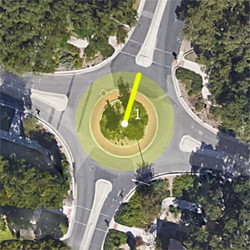Route Roundabout
 You stumble on a roundabout.
You stumble on a roundabout.
You believe without a doubt
there is no more reason to pout.
It makes you want to scream and shout.
You and ride and ride and ride and ride.
To the thrill you now abide.
Your heart flung open wide and wide.
Round and round you feel sublime;
Went 50 to 100 times.
You forgot, but feel no shame:
Each possibility's the same.
Assume the radius is 1.
How far might you have had your fun?
Details and assumptions :
- You travel on a fixed track around the circumference; don't add the distance it would take to turn upon exiting.
- Round your answer to the tenth's place.
- There is one exit on each of the four corners of the circle.
Inspired by riding my bicycle around the roundabout in the picture.
Satellite image was taken by Google. No copyright infringement intended.
The answer is 471.2.
This section requires Javascript.
You are seeing this because something didn't load right. We suggest you, (a) try
refreshing the page, (b) enabling javascript if it is disabled on your browser and,
finally, (c)
loading the
non-javascript version of this page
. We're sorry about the hassle.
Let d be the expected distance that you travelled.
Let τ = 2 π (see tau manifesto )
Method 1:
Because the chances are uniformly distributed, we can take the maximum possible distance and average it with the minimum possible distance .
d = 2 5 0 τ + 1 0 0 τ = 7 5 τ ≈ 4 7 1 . 2
Method 2:
Python 3.3:
⟹ d ≈ 4 7 1 . 2